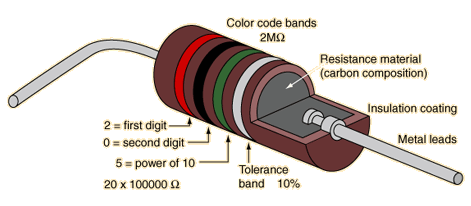Ohm

Figure 1. A carbon resistor with the resistance of 2 MΩ, the colour code gives the resistance in Ohms.[1]
The Ohm (Ω) is a unit of electrical resistance, measured in volts/ampere, to quantify the resistance in resistors, conductors, or even electrical insulators..[2]
Measurements of resistance go from 0 Ω for superconductors to ~ for a cm block of metal like copper or aluminum and up to ~ for a block of sulfur.[3][4] Very few physical measurements have spanned 25 orders of magnitude like this (for length, that's a ratio of the thickness of a fingernail to the size of a galaxy)!
To learn more about the Ohm please see Dr. Rowlett's dictionary of units.
References
- ↑ Hyperphysics. (August 28, 2015). Carbon Resistors [Online], Available: http://hyperphysics.phy-astr.gsu.edu/hbase/electronic/rescarb.html
- ↑ Hyperphysics. (August 28, 2015). Ohm's Law [Online], Available: http://hyperphysics.phy-astr.gsu.edu/hbase/electric/ohmlaw.html
- ↑ Hyperphysics. (August 28, 2015). Table of Resistivity [Online], Available: http://hyperphysics.phy-astr.gsu.edu/hbase/Tables/rstiv.html#c1
- ↑ PeriodicTable. (August 28, 2015). Technical data for the element sulfur [Online], Available: http://www.periodictable.com/Elements/016/data.html

